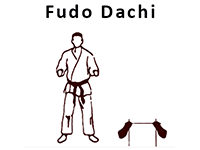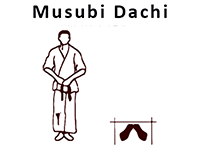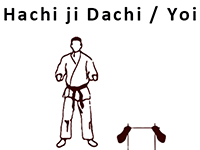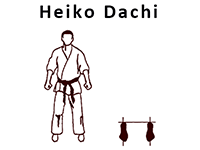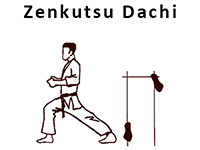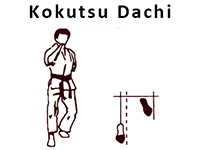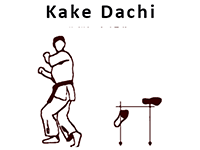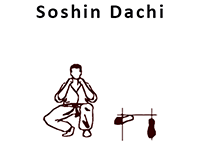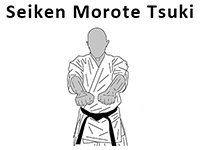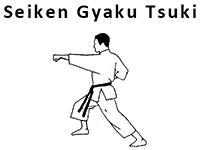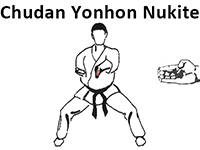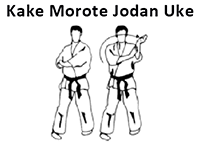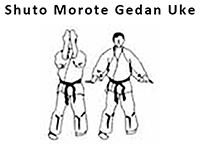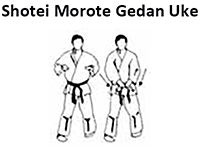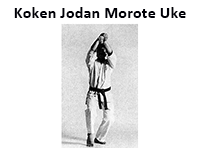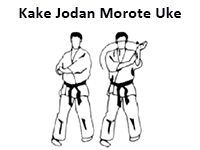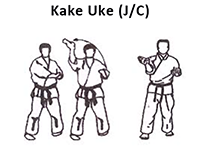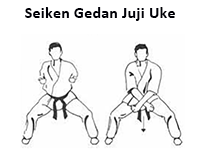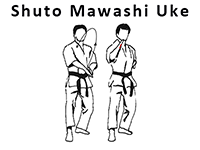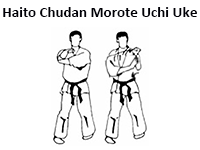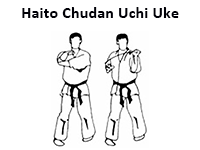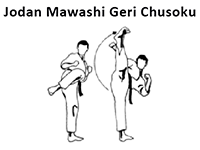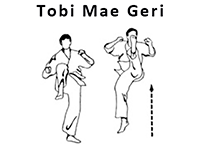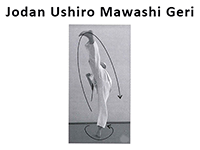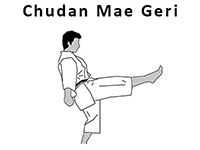|
Begin the Kata in FUDO DACHI. Move into MUSUBI DACHI and MOKUSO on the command MOKUSO. On the next command Garyu, open eyes and wait until the command YOI. Then start perform a slow YOI DACHI with IBUKI that ends in HEIKO DACHI |
 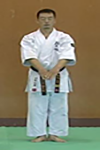 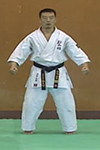 |
| 1. |
On the command HAJIME/ICHI, still in position, block left KAKE JODAN MOROTE UKE (starts from the right hand site of your neck), supported with your right hand in the middle of your fore-arm (this hand is ready for a NUKITE to the opponents face). |
 |
| 2. |
In the same position kick a right JODAN MAWASHI GERI CHUSOKU. |
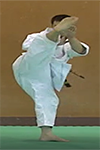 |
| 3. |
Block a right KAKE JODAN MOROTE UKE, supported with your left hand. |
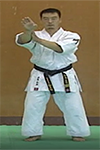 |
| 4. |
In the same position kick a left JODAN MAWASHI GERI CHUSOKU. |
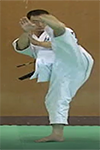 |
| 5. |
Jump back with your right foot in left ZENKUTSU DACHI while making SHUTO MOROTE GEDAN UKE, a double block with the open hands. |
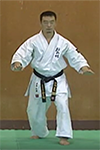 |
| 6. |
Kick a left TOBI MAE GERI, followed by a JODAN MOROTE TSUKI with KIAI. |
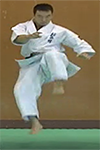 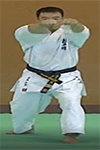 |
| 7. |
Step forward in right KOKUTSU DACHI and make a right KAKE JODAN MOROTE UKE, supported with your left hand (1). |
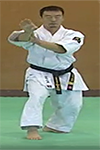 |
| 8. |
Step forward in left KOKUTSU DACHI and make a left KAKE JODAN MOROTE UKE, supported with your right hand (2). |
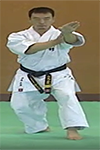 |
| 9. |
Step forward in right KOKUTSU DACHI and make a right KAKE JODAN MOROTE UKE, supported with your left hand (3). |
 |
| 10. |
Step forward in left KOKUTSU DACHI and make a left KAKE JODAN MOROTE UKE, supported with your right hand (4). |
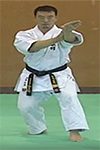 |
| 11. |
Step back in right KOKUTSU DACHI (move left foot back), while blocking a left SHOTEI MOROTE GEDAN UKE (right SHOTEI is on top of the left), immediately block upwards by a left KOKEN MOROTE JODAN UKE (right KOKEN is on top of the left) (1). |
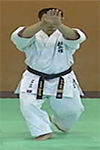 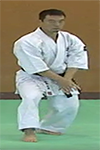 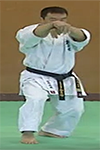 |
| 12. |
Step back in left KOKUTSU DACHI, while blocking a right SHOTEI MOROTE GEDAN UKE (left on right), immediately block upwards by a right KOKEN MOROTE JODAN UKE (left on right) (2). |
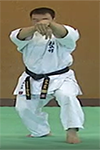 |
| 13. |
Step back in right KOKUTSU DACHI, while blocking a left SHOTEI MOROTE GEDAN UKE (right on left), immediately block upwards by a left KOKEN MOROTE JODAN UKE (right on left) (3). |
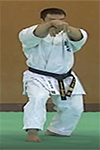 |
| 14. |
Step back in left KOKUTSU DACHI, while blocking a right SHOTEI MOROTE GEDAN UKE (left on right), immediately block upwards by a right KOKEN MOROTE JODAN UKE (left on right) (4). |
 |
| 15. |
In the same position kick right JODAN MAWASHI GERI HAISOKU, followed by e left JODAN USHIRO MAWASHI GERI (both connected) and step into left KOKUTSU DACHIand block a left KAKE JODAN MOROTE UKE (left hand supported with your right hand). |
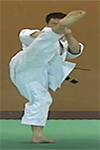 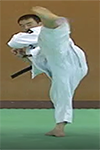 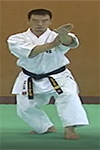 |
| 16. |
Step forward in right KOKUTSU DACHI and make a left KAKE JODAN MOROTE UKE (1). |
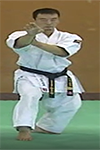 |
| 17. |
Step forward in left KOKUTSU DACHI and make a right KAKE JODAN MOROTE UKE (2). |
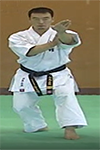 |
| 18. |
Turn 270° back in right KOKUTSU DACHI and make a right KAKE JODAN MOROTE UKE (3). |
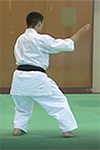 |
| 19. |
Move the left leg across and turn 180° counterclockwise into left KOKUTSU DACHI and make a left KAKE JODAN MOROTE UKE, supported with your right hand (4). |
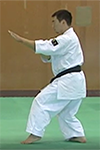 |
| 20. |
Leap sideward into KAKE ASHI DACHI (jump with the right foot sideward, followed by the left one, behind the right one) and block a right KAKE MOROTE UKE, supported with the left hand, with KIAI. |
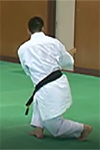 |
| 21. |
Jump high in the air, turn 180° counterclockwise and land in a low KAKE ASHI DACHI (a crossed leg crouching position) and block a right SEIKEN JUJI GEDAN UKE. |
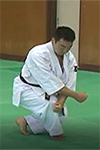 |
| 22. |
Stay low and move the right leg 90° clockwise into right SOSHIN DACHI and block a right SHUTO MAWASHI UKE. |
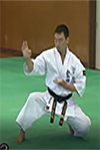 |
| 23. |
Make a right KAKE CHUDAN UKE (slow hook), followed by a left CHUDAN GYAKU TSUKI. |
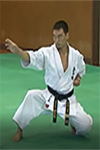 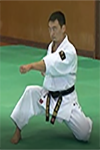 |
| 24. |
Bring your weight on the right leg and move the left leg across and turn 180° counterclockwise into left SOSHIN DACHI
| 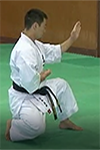 |
| 25. |
Make a left KAKE CHUDAN UKE (slow hook), followed by a right CHUDAN GYAKU TSUKI. |
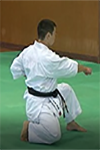 |
| 26. |
Open both hands and slowly extend both arms forward and to the side, bring them to the SUNI of the opponents kicking leg (left on top - knee, right below - ankle). |
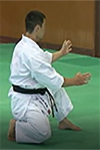 |
| 27. |
Stand up whilst moving forward into right KOKUTSU DACHI and block a right HAITO CHUDAN MOROTE UCHI UKE (supported with your left hand) (1). |
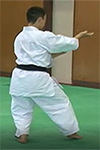 |
| 28. |
Step forward into left KOKUTSU DACHI and block a left HAITO CHUDAN MOROTE UCHI UKE (supported with your right hand) (2). |
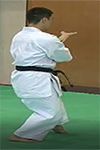 |
| 29. |
Step forward into right KOKUTSU DACHI and block a right HAITO CHUDAN MOROTE UCHI UKE (supported with your left hand) (3). |
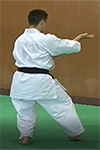 |
| 30. |
Move the left foot across and turn 180° counterclockwise into left KOKUTSU DACHI, and block a left HAITO CHUDAN UCHI UKE, followed by left CHUDAN GYAKU YONHON NUKITE with KIAI.
|
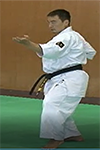 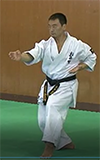 |
|
Move the left fgoot back inot MUSUBI DACHI and the MOKUSO position is retained. The Kata is completed on the command NAORE and the FUDO DACHI position is taken.
At the command YASMEE relax and at ease.
Back to Top |
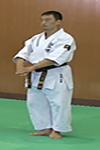
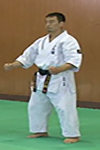
|









































